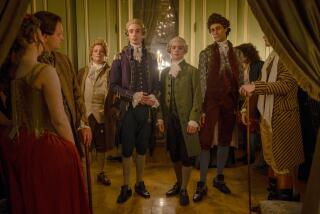The heady future of men’s hats: Hawaiian prints, and patterns to match your tie
- Share via
My elegy on the passing of men’s hats brought tears to a few eyes.
Louis M. Fisch of Van Nuys recalls that his family owned a cap manufacturing plant on South San Pedro Street from 1921 to 1955.
In those days, he says, men wore hats with such prestigious labels as Dobbs, Stetson, Cavanagh, Disney, Mallory and Knox, and they drove Cadillacs, Pierce-Arrows, Packards and Lincolns.
He remembers when every big department store and men’s shop had a hat department you could find without asking a salesclerk.
“Try and find one today,” he says.
Fisch believes that men’s hats began to go out at the end of World War II.
“This period marked a great shift on the part of the public from three-piece suits to informal, comfortable and colorful sportswear.
“Let’s face it. A stiff felt fedora, a sailor straw or a panama looks kind of silly with a jogging suit.”
Manufacturers haven’t been able to come up with anything more imaginative to replace the hat than baseball and golf caps, “which look kind of silly with a three-piece suit or a tuxedo.”
Fisch got stung on a cap he produced for the 1932 Olympic Games--a white beret type with a blue visor and the Olympic rings across the front. He sold 2,500 to the Olympics committee for its employees, making only a small profit, but he hoped to sell many thousands more to visitors. He sold only three dozen.
Fisch believes men’s hats will make a comeback, but when they do they will be in soft, crushable cloth, leather and knit, rather than felt and straw.
“They will be in patterns like plaids and Hawaiian prints and tasty neckwear designs that blend with the sportswear now on the market.”
Come on, Fisch. Men’s hats in Hawaiian prints? I’d rather go bareheaded.
Martin E. Mullen Jr. recalls that in the 1920s and ‘30s gangsters not only wore the fedora invariably, but they used it to shield their faces from photographers.
“Camera-shy tough guys in those days learned to manipulate their fedora with such skill that photo editors often found themselves studying pictures of men who apparently had grown hats in place of their heads.”
But he remembers that the principals in one of that era’s biggest crime stories did not wear fedoras.
“As for the straw skimmer,” he says, “I associate it, not with Harold Lloyd, but with Public Enemy No. 1--John Dillinger--and his G-man nemesis, Melvin Purvis.
“Both men, as I recall, wore boaters on that fateful July night in 1934 when Dillinger met his end in a blast of FBI gunfire outside a Chicago movie house.”
If I remember that bloody episode correctly, Dillinger was fingered for the FBI by the notorious “woman in red.” The outlaw’s face had been altered by plastic surgery, and his girlfriend told the FBI she would be wearing red when they emerged from the theater, so they could spot him.
Mullen’s own fantasies are fixed on the British army’s pith helmet--the kind worn by Victor McLaglen, Cary Grant and Douglas Fairbanks Jr. in “Gunga Din.”
“That captured my youthful fancy. For me it symbolized Kipling’s India and a life of adventure on the Northwest Frontier.
“I’ve sometimes thought about what I might do if such a hat came into my possession today. I can’t picture myself wearing a pith helmet while strolling down Rodeo Drive, but I’ll bet I could get away with it on Hollywood Boulevard.”
Why not Rodeo Drive? Isn’t there a Banana Republic store out there?
When I was a youth I had the notion that I was going to go up the Amazon River. I bought a pith helmet with a genuine cork lining, preparing for that adventure. I have yet to see the Amazon River, but that cork hat symbolized my youthful dream. I don’t remember what happened to it.
Today I have about 30 caps and hats, and I realize now that they also symbolize my fantasies. I have a rugged Irish country hat, made in the Republic of Ireland, but I have never been to Ireland. I have a Scottish plaid cap, made in Scotland, and given to me by the late Robert Nathan. Alas, it is a cap whose bill juts out, needing to be balanced by the kind of strong jaw that Nathan had. On me it looks as if it’s going to tip me over frontward.
I have at least half a dozen Greek fisherman’s caps in navy blue wool, blue denim and white cotton, with embroidered bills. They represent a more rakish, reckless, adventurous me.
I also have a brown corduroy Mexican cap I bought in Ensenada. It is closer to the real me than any other headgear I own.
I don’t believe I mentioned the homburg in my eulogy. The homburg is the hat of my mature fantasies. I have rarely seen it worn. It is the hat of class. Once, when I called on the American ambassador to Greece in his Athens apartment, I saw his homburg on the mantle.
On another occasion, when I went to the Beverly Hilton to interview Eugene Black, president of the World Bank, I also saw a homburg on the mantle.
I confessed to Mr. Black that I had no idea what the World Bank did. In a few exquisitely chosen words, he told me. Then he reached for his homburg, put it on, and said, “Now, let’s go downstairs and have a drink.”
Maybe if Ronald Reagan wore a homburg he could repair his international image.






